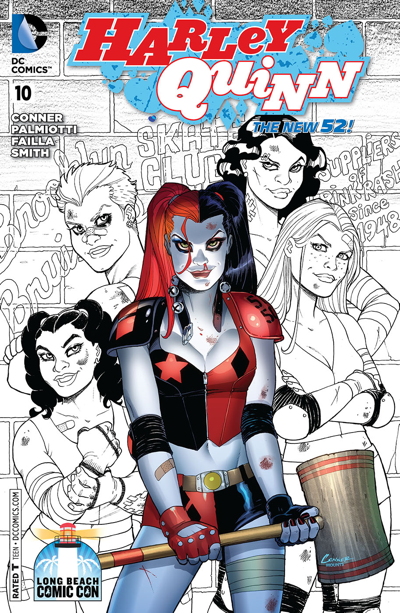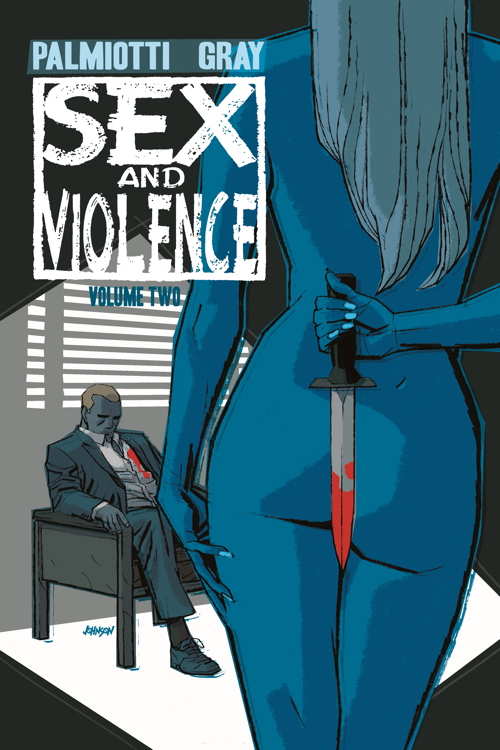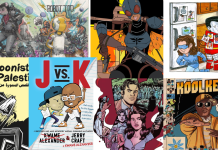Everyone should “Listen to JImmy” Palmiotti that is. The veteran writer, artist editor and publisher is one of the most knowledgeable comics people out there. With his collaborators from Paperfilms, Justin Gray and Amanda Conner, he’s made a small publishing enterprise out of kickstarting a series of graphic novels based on the European album format. The seventh, Sex and Violence Vol. II is ending in a few days and we advise you to get in on the Amanda Conner/Dave Johnson action as soon as possible — the books will not be sold in any other way. We talked to Palmiotti a few months ago when he was Kickstarting the SF tale Denver and got his overall thoughts on using Kickstarter as a platform. This time out we talk about the storytelling process,finding artists and also find out how Harley Quinn, which he co-writes with Amanda Conner, has become one of DC’s bestselling titles, with a huge female fan base.
The Beat: Sex and Violence is billed as stories of “crime, lust, and redemption.” Are these stories that you carried around for a while or did you sit down to think of them just for this volume?

Palmiotti: I can’t speak for Justin, but I have had the FILTER story idea for a while and was at one point going to pitch it as a series, but never got around to it. I reworked it so it can be enjoyed as a single story with a beginning and an end. The other short story was something I came up with and thought it might fit perfectly into the book. A lot of the time story ideas hit me and I keep files on them, waiting for the right time or opportunity to place them. I have another story that I want to do and hope we can get to a volume 3 of this series.
The Beat: I know Justin Gray wrote one of the stories, but can you tell us a little about each of the three stories, and what interested you enough in your two to tell the tale?
Palmiotti: Justin’s is called RED DOG ARMY and its based on actual history. Hitler launched a full-scale invasion on Russia called Operation Barabossa, and Stalin, reacting to this, authorized a special unit to train dogs as anti-tank weapons, sort of a suicide dog squad. It’s a real interesting setting to tell a story and beautifully illustrated by Rafa Garres whom we worked a number of time with on Jonah Hex. The next story is called DADDY ISSUES and is about a mother and daughter living in a trailer park dealing with the men in their lives. Its got a very tales from the crypt feel but works perfectly here. Romina Moranelli illustrated it and it’s just beautiful. The last story is called FILTER and it’s a look back on a killer’s life and the things he has done to get to where he is today. It’s dark and cruel and will stay with you for a while, I think. Vanesa R. Del Ray illustrates that story, an art student I met a couple of years ago that is making a name for herself all over now. All three stories work together pretty nicely.
The Beat: Your two stories sounds like they have fairly unsympathetic protagonists, which I know can be a challenge. How do you make dark characters like this compelling enough for the reader to want to follow along?
Palmiotti: Well, with Daddy Issues, you sort of understand what they are going through, but in the end, these are killers and you should be scared to be around them. With Filter, I set out to give the reader an understanding of how someone goes from bad to worse. The interesting aspect of the story is there is a level or redemption to the character that makes him a bit more sympathetic. I think the trick is to humanize the situation into something we can relate to so we understand the extreme reaction the character takes. Honestly, all of these characters are scary on their own level.
The Beat: How do you find artists for these? You’ve said it’s like casting, and as a sometimes editor, I know exactly what you mean. Sometimes you think of an element of a comics story and an artist just pops into your head with just the qualities that will make it work. Do you keep a physical or mental folder of artists you want to work with?
Palmiotti: I actually meet most of them at conventions. They come by and show me their work and I can feel the enthusiasm. I keep a file and also give them my contact and hope they follow through and we chat again. The people that I end up working with are the ones that stay after me and keep sending their latest samples. I try to stay up as well on who is new and exciting in the field best I can. I buy just about every new book that comes out, which my local retailer, Emerald City loves. The casting thing is a perfect way of explaining what I do for each story, It’s one of the most important parts of the job. I always say the Marvel Knights gig was all about casting the right people with the right characters. The magic happens after that.
The Beat: Do you ever write a story for a specific artist?
Palmiotti: All of the time. All three of the stories in Sex and Violence are catered to the artist. I may have an idea, but once I know who the artist is going to be, I change it to fit their style. In the case of All Star Western and Jonah Hex, we always wrote for the artist. I think that’s how we got their best work. Issue 34 of All Star was made for Darwyn Cooke and once we knew G.I.Zombie was going to be Scott Hampton, the book took a creepier, grounded tone. I didn’t want to fight against his style. I also think the work is better for it.
The Beat: I talked with you a few months ago for your Denver Kickstarter and it sounds like you really have crowdfunding down to a science. Were there any tweaks to the model this time?
Palmiotti: Yes, I did a few after the Denver Campaign. The first thing I did is stop offering the expensive packages overseas because we felt the price was too high to ask for the shipping and to be honest, a lot of the packages got lost or damaged pretty bad. The next thing was limit the prints because we felt there wasn’t as big a need for them this time, and last, since this is a follow up of a series of books, we went back to press and reprinted the first book with two brand new covers by Amanda Conner and Dave Johnson, knowing a lot of people did not get the first one that might be backing the new one.
The Beat: Your Kickstarter books seem to have a very European feel to them and not just because you often use foreign artists. Is that part of the inspiration for these books?
Palmiotti: It’s based on my love of European comics and artists. I grew up on Heavy Metal and with that steady diet; it was bound to have its influence. I also like to make the books mature audience books, again, a very European thing. I feel I do a ton of all ages work for the mainstream, so we get to unleash ourselves here and do whatever works for the story.

Palmiotti: Amanda and I have had a very busy year of conventions and signings and the thing we noticed from working on the Harley book is that the majority of the people coming up to us are females of all ages. We have only had this happen once before and it was for the Painkiller Jane series. The cool thing about this group is that we’ve had a large percentage telling us it’s the first comic book they ever bought and thanking us for not weighing down the title with continuity. They say they love that they can just pick up an issue and enjoy it without going broke or feeling left out and confused because they haven’t bought 15 other books. It’s something I am always aware of on all my books because I’m one of those people that, if I feel lost picking up a book, I never go back to it again.
What we are learning is that the traditional idea of done–in-one stories not selling in comics just doesn’t apply to the new audience buying the books, and believe me, most of that new audience are female. I think the problem right now is we have some people running the companies that just aren’t going out and trying new comics or interacting with the next wave of readers and keep pushing things the traditional way they did years ago. The retailers themselves are seeing this happening daily now and I feel it’s the reason Image comics will continue to grow and eventually outsell the big two, unless they start thinking outside the box and just make superheroes a PART of their publishing plan and not the entire thing and start looking at the different ways a superhero type of book can be done. Harley is one example , Hawkeye is another . The traditional graphics people associate comics with have been changing for years now and the market is embracing different looks and styles that are outside the house style and its pretty cool to see.
The thing that keeps me interested in comics is the prospect of new ideas, new voices and especially new methods of applied technology and connecting with the audience. It’s what keeps the Paperfilms crew and I trying new things all the time. As an example, we had a soundtrack scored on our last book DENVER and people loved it. That and the fact that people can go to Paperfilms.com and get digital downloads of our books, prints of Amanda’s work and copies directly from us is the next big for creators these days. That thing is the connection between the creator and the fan; something bigger companies have no real interest in promoting. This is also happening in all media. Things are changing fast, and for me, all for the better.
The Beat: You’ve made your Kickstarters a real cottage industry, What are your plans going forward? How many a year do you foresee doing and how long are you going to keep at it?
Palmiotti: I will keep making Kickstarters for as long as we have an audience for them. The people that back our Kickstarters are a lot of repeat customers and we are growing that fan base with every project. Our plans going forward are to do more of them and take on less work that we just do to pay the bills. Kickstarter has been a huge learning experience for us in so many ways. Each project teaches us what the audience wants from us. We look at the hard numbers, the comments and all the interaction and fine tune each and every new project to be able to connect better with the fans. We have only a few days left on SEX AND VIOLENCE VOL. 2 and after this, we have another book ready to roll that is a western graphic novel, something you would think we had enough of…but this one is different in a number of ways and we are super excited to announce it in a few weeks.











Compare the cover of Sex and Violence 2 to the paperback of Lawrence Block’s Getting Off: A Novel of Sex and Violence.
I did. I like Dave’s cover much better.
Sure, but that’s not my point. I just thought it was an odd coincidence (and that’s all I’m suggesting it is!) that two works with such similar titles would have such similar cover images–backal nudity and the oxymoron of a naked woman with a concealed weapon.
The Block cover is by Gregory Manchess (of whom l never heard before) and, like many Had Case Crime covers is an attempt to evoke the look of the Gold Medal paperbacks of the sixties .
The main thing I like better about the Manchess painting is that it’s obvious in it from whom she’s hiding the knife.
Yeah, they both have their advantages, but I spoke to Dave and its just the way art happens, two guys with the same idea. Both were probably done to hide the nudity somewhat, but with Daves, there is more questions raised. What I found really weird was that it has the title SEX AND VIOLENCE on the original cover. That was a bit freaky.
Of the Big Two, DC seems to be the dumber with regard to the shifting marketplace. Marvel has fifty plus years of I.P. invested in an inter-connected universe. They have managed to export that aspect of their brand to other media. Changing the way that they do things doesn’t make a ton of sense.
DC, on the other hand, has a TON of properties that work better in a less continuity intense environment. They have enough War characters to have their own universe. They have Western characters (although Marvel does, too). They have horror/dark fantasy characters. They have sci-fi characters. They have humor characters (again, another area in which Marvel has idle I.P.). They have Jungle Adventure characters. They have (great) Sword & Sorcery characters. They superheroes that are wonderful, but an awkward fit with a Marvel-style shared universe. Moreover, they have a whole multiverse to populate with all these different genres.
DC could easily publish a half-dozen “mini lines” that appealed to lots of different audiences and reach them all digitally. Instead … Batman … Batman Family …. Bat Spin-Offs. I love Batman, but ….
Comments are closed.